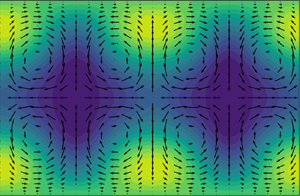Article contents
Linear feedback control of invariant solutions in channel flow
Published online by Cambridge University Press: 05 August 2020
Abstract

Considering channel flow at Reynolds numbers below the linear stability threshold of the laminar profile as a generic example system showing a subcritical transition to turbulence connected with the existence of simple invariant solutions, we here discuss issues that arise in the application of linear feedback control of invariant solutions of the Navier–Stokes equations. We focus on the simplest possible problem, that is, travelling waves with one unstable direction. In view of potential experimental applicability we construct a pressure-based feedback strategy and study its effect on the stable, marginal and unstable directions of these solutions in different periodic cells. Even though the original instability can be removed, new instabilities emerge as the feedback procedure affects not only the unstable but also the stable directions. We quantify these adverse effects and discuss their implications for the design of successful control strategies. In order to highlight the challenges that arise in the application of feedback control methods in principle and concerning potential applications in the search for simple invariant solutions of the Navier–Stokes equations in particular, we consider an explicitly constructed analogue to closed-loop linear optimal control that leaves the stable directions unaffected.
JFM classification
- Type
- JFM Papers
- Information
- Copyright
- © The Author(s), 2020. Published by Cambridge University Press
Footnotes
Deceased on the 7th of August 2019.
References
REFERENCES
- 8
- Cited by




